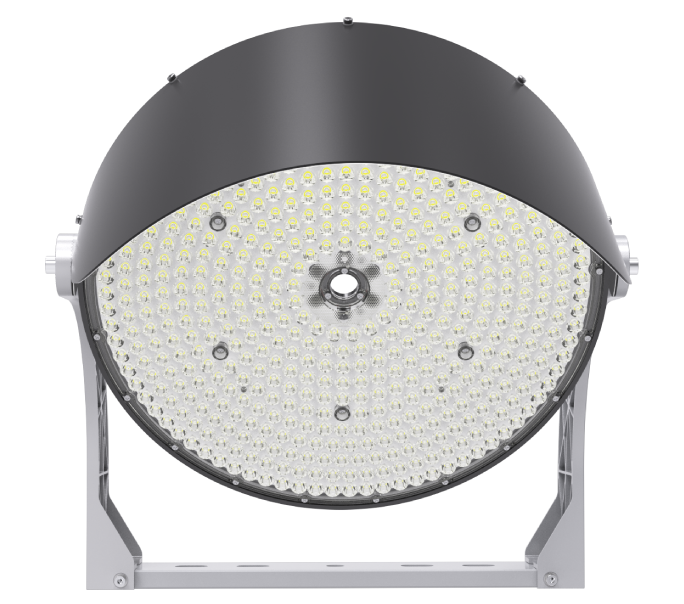Football Stadiums Lighting Requirements: Best Led Football Stadium Lights
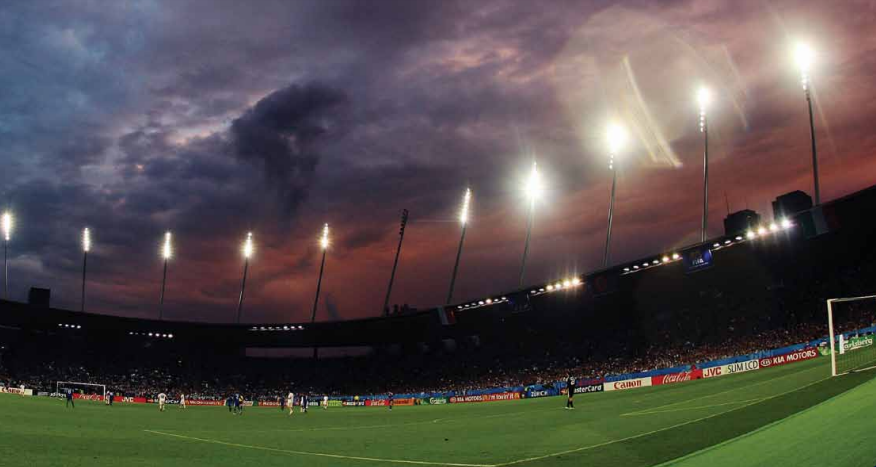
Directory:
1. Basic Terms
2. Examination of Innovative Technologies for Football Stadium Illumination
3. Best Led Football Stadium Lights
In the electrical design of soccer fields, lighting is a crucial element that must cater to the needs of players, spectators, and emergency situations. For top-tier venues, it also has to accommodate television broadcasts and on-site advertising.
The recent changes to artificial lighting standards for soccer fields by the International Football Federation (FIFA) will significantly influence stadium construction in my country. Eco-friendly lighting for soccer fields encompasses various aspects, including resource efficiency, reliability, durability, health, and comfort. This article examines the new FIFA standards and compares them with domestic standards regarding illumination, power supply, lighting layout, strobe effects, and other important factors, all from a green energy-saving perspective. It also discusses the future direction of specialized soccer field lighting design in my country.
1. Basic Terms
1.1 illuminance
E-illuminance; Eh - horizontal illuminance; Ev - vertical illuminance; Emax - maximum illuminance; Emin - minimum illuminance; Eave - average illuminance; Ehmin - minimum horizontal illuminance; Ehave - average horizontal illuminance; Evmin - minimum vertical illuminance; Evave - average vertical illuminance; Evmai - vertical illuminance towards the main camera; Evaux - vertical illuminance towards the auxiliary camera.
1.2 Uniformity
U - illumination uniformity; U1h - ratio of minimum horizontal illumination to maximum horizontal illumination; U2h - ratio of minimum horizontal illumination to average horizontal illumination; U1v - ratio of minimum vertical illumination to maximum vertical illumination; U2v - ratio of minimum vertical illumination to average vertical illumination; Uvmai - vertical illumination uniformity towards the main camera; Uvaux - vertical illumination uniformity towards the auxiliary camera; U1.vmai - ratio of minimum vertical illumination to maximum vertical illumination towards the main camera; U2.vmai - ratio of minimum vertical illumination to average vertical illumination towards the main camera; U1.vaux - ratio of minimum vertical illumination to maximum vertical illumination towards the auxiliary camera; U2.vaux - ratio of minimum vertical illumination to average vertical illumination towards the auxiliary camera.
1.3 Additional Parameters
Tcp - correlated color temperature; Ra - general color rendering index; FFave - average flicker ratio; FFmax - maximum flicker ratio; GR - glare index; MCM - light continuity mode; MAUR - minimum adjacent uniform ratio; MF - maintenance factor.
2. Examination of Innovative Technologies for Football Stadium Illumination
2.1 Illumination Standards
The regulations in my country regarding the classification of lighting in sports facilities are presented in Table 1.
table1 Functional classification of lighting in sports venues
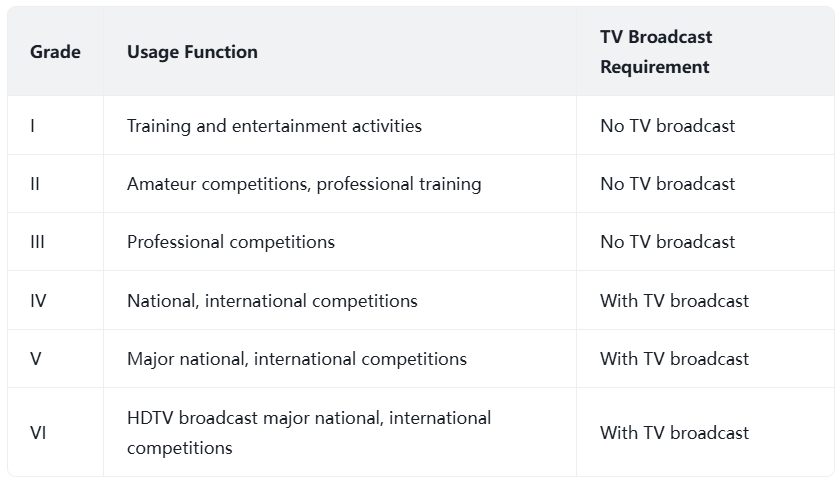
Chapter 4 of the FIFA standard for artificial lighting on football stadiums suggests that lighting should be categorized based on the type of events taking place. The guidelines for various event types are detailed in Table 2.
table2 Lighting level and power supply standards
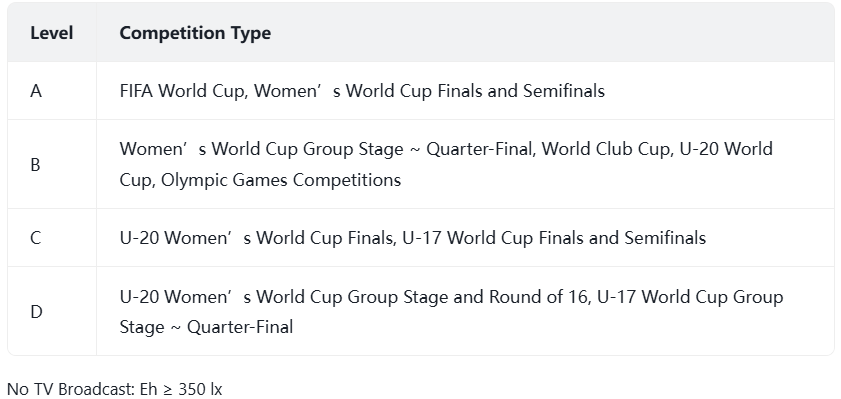
Table 2 illustrates that FIFA categorizes broadcasting events into four levels: A, B, C, and D, each with specific technical requirements. For football stadiums lacking television coverage, a minimum horizontal illumination of 350lx is mandated. In contrast to domestic standards, FIFA establishes lighting criteria for each level of the same event, which helps to lower energy consumption for lighting and addresses the sustainable use of venues following large-scale events to some degree.
2.2 Examination of lighting standards
From a resource conservation standpoint, the FIFA lighting standards for football stadiums have undergone significant modifications in several areas.
(1) The ratio of horizontal illumination to average vertical illumination has been enhanced. Figure 1 compares the domestic standards with FIFA standards regarding this ratio for football stadiums equipped with television broadcasting.
fig1 Ratio of average horizontal illuminance to average vertical illuminance
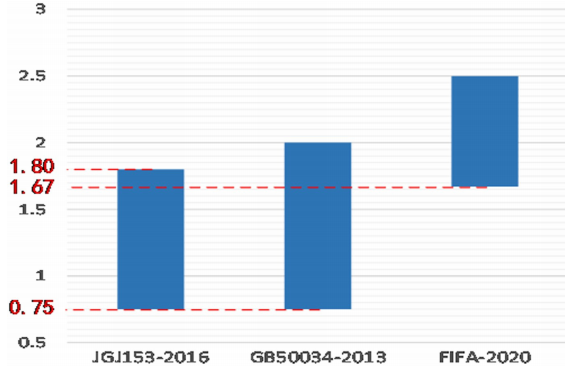
(2) Updated criteria for horizontal and vertical illuminance. The regulations from FIFA and local standards are illustrated in Figure 2. FIFA standards explicitly define the minimum and average values, and lighting design must satisfy both of these criteria simultaneously.
fig2 Standard lighting values for dedicated football stadiums
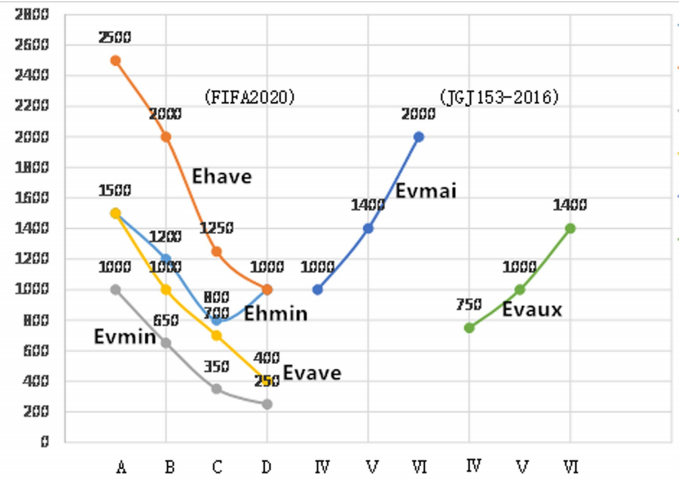
Figure 2 illustrates that FIFA's standards for horizontal and vertical illuminance have been lowered, resulting in a significant range of indices across the four levels: A, B, C, and D. This indicates that the illumination levels for group matches, semi-finals, and finals within the same tournament can vary considerably. To ensure that the lighting on dedicated football stadiums meets the highest standards for high-definition broadcasting and can be adjusted accordingly, an intelligent lighting control system is essential. Dimming capabilities will allow for different illumination levels to cater to the varying requirements of events at different tiers.
(3) The index for illumination uniformity has also been decreased. The FIFA standards and domestic regulations regarding horizontal and vertical illumination uniformity are depicted in Figure 3.
fig3 Illumination uniformity
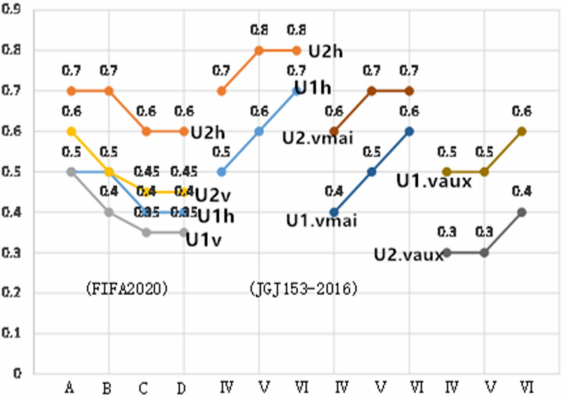
As illustrated in Figure 3. the illumination uniformity index for FIFA's A-level events matches the index set for the lowest-tier venues according to domestic standards. In fact, the domestic criteria for the illumination uniformity index of dedicated football stadiums exceed FIFA's standards.
(4) There are new stipulations regarding vertical illumination for both main and auxiliary cameras. Domestic standards require that during major competitions, the vertical illumination directed at the auxiliary camera must meet the illumination levels on the vertical plane in all four directions surrounding the venue. Typically, the vertical illumination for the auxiliary camera is one level lower than that for the main camera. FIFA also evaluates vertical illumination and its uniformity based on four directions (0°, 90°, 180°, 270°), with the main camera positioned at the 270° angle. The requirements for vertical illumination and uniformity for both the main and auxiliary cameras across these four directions are identical. Additionally, unlike domestic standards, FIFA mandates that the vertical illuminance test point facing the main camera be set at a height of 1.0 m above the field, whereas domestic regulations require it to be 1.5 m. Consequently, when constructing football stadiums, the design of the horse trails must be planned in advance to meet the necessary illuminance levels.
(5) The color rendering index has been revised. For FIFA's C and D level football stadiums, a value greater than 70 is adequate, while A and B levels necessitate a value greater than 80.
(6) The standard for color temperature has also been updated. Unlike the domestic requirement for a minimum color temperature index, FIFA specifies a color temperature range for the four levels of fields, as depicted in Figure 4.
fig4 Color temperature range for each level of venue

(7) Include MCM requirements: A-level venues must not experience interruptions, B-level venues need to achieve horizontal illumination of over 1.000 lux within 3 minutes and over 2.000 lux within 15 minutes, C-level venues require horizontal illumination of over 1.000 lux within 3 minutes and over 1.250 lux within 15 minutes, while D-level venues have no continuity requirements.
(8) Introduce a flicker ratio index; each venue level must comply with both the maximum and average flicker ratio index requirements. Detailed specifications for the flicker ratio index will be provided in Section 2.5.
(9) Implement a minimum adjacent uniformity ratio (MAUR) indicator; rapid fluctuations in illumination levels on any plane can lead to inconsistent camera exposure. This parameter is akin to the uniformity gradient in domestic standards and is intended to ensure consistent camera exposure. The uniformity gradient is defined as the illumination ratio of a grid point to its eight neighboring grid points. The MAUR indicator is assessed using one main grid point and four secondary grid points. The difference in illumination values between any two adjacent points must not exceed the allowable limits set for each venue level. D-level venues do not have any requirements in this regard. The minimum adjacent uniformity ratios for A, B, and C levels are 0.6. 0.6. and 0.5. respectively.
(10) Different maintenance factor values are suggested for LED and HID lighting. The maintenance factor values are set at 0.8 for LED and 0.9 for HID.
2.3 Lamp Arrangement Analysis
Proper and comfortable lighting is crucial for the design of green football stadiums. As a result, certain areas of the fields are restricted from having lighting fixtures, and it is essential to adhere to regulations regarding glare and stray light control. According to Article 6.2.2 of JGJ153. football stadiums designated for TV broadcasts can utilize lighting arrangements on both sides of the field, place lamp poles at the four corners, or implement a combination of both.
(1) When using the arrangement on both sides of the field, the lamp positions must comply with the specifications illustrated in Figure 5.
Figure 5: Single row (left) and double row (right) lamp positions

It is not allowed to position lamps within a 15° angle on either side of the bottom line of the figure above. According to FIFA standards, lamps may be placed in the restricted area, regardless of whether a multi-pole setup or a light strip configuration is used, as illustrated in Figure 6.
Figure 6 Prohibited lighting areas required by FIFA2020
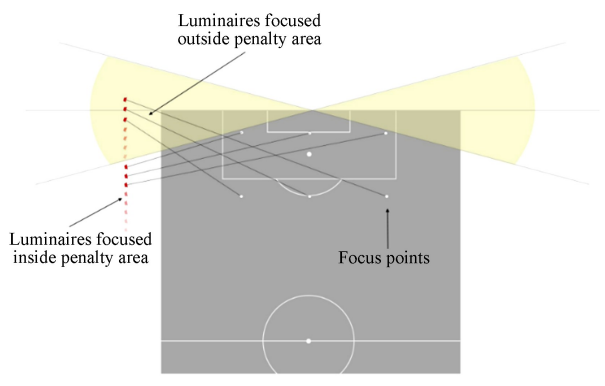
The projection point of the lamps in the restricted area must be located outside of that area, with lighting in the restricted area being provided by lamps positioned in other areas to create a complementary effect. According to the latest FIFA standards, which take into account practical implementation and actual lighting measurements, there are also specifications regarding the installation height and aiming angle of lamps on a single horse track to minimize glare.
(2) When arranging the four corners of the field, the "Lighting Design Manual" outlines the positions and installation heights of the lamps, as well as the distance from the lamp pole to the center of the field. Additionally, the height of the lamp must ensure that the angle formed between the line connecting the lowest row of lamps to the center of the field and the plane of the field is at least 25°, as illustrated in Figure 7.
Figure 7: Position diagram of lamps arranged at four corners
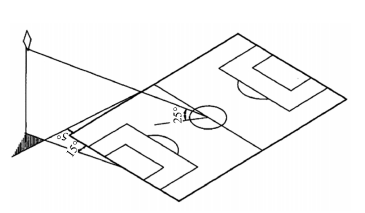
In contrast to national regulations, the FIFA standard alters the configuration of the four corners and specifies that the lamp pole must be positioned in the area depicted in Figure 8. This area is defined by angles of 120° from the goal line and 120° from the field's boundary, with the lamp pole needing to be more than 12 meters from the corner kick. Typically, the ideal height from the lamp pole to the center of the lamp fixture is between 40 and 45 meters.
Figure 8. Position diagram of lamps arranged at four corners
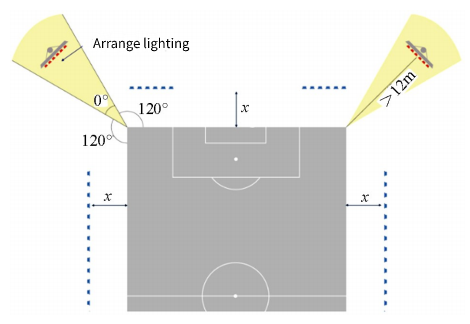
(3) Circular Lamp Arrangement
Both the Chinese standard and the previous FIFA standard do not endorse the circular arrangement of lights. The FIFA standard represents a significant advancement in this area. When using a circular lamp arrangement for field lighting, it is essential to keep a sufficient lateral distance "x" from the edge to achieve the necessary vertical illumination levels and uniformity, as indicated in Table 5. Typically, this circular arrangement involves creating a pathway on the stadium roof for lamp installation.
table5 Reference for lateral distance of lamps
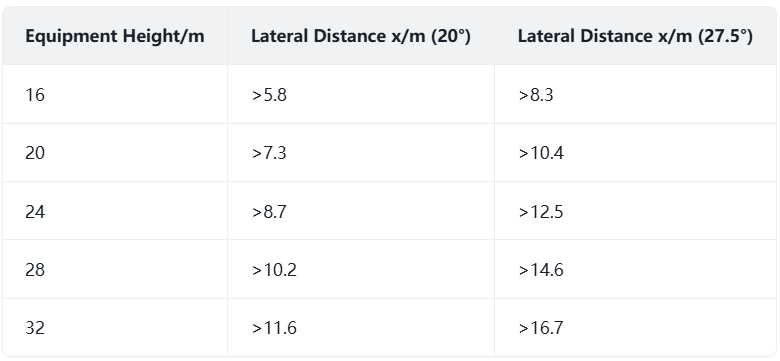
To ensure that players' facial shapes are adequately illuminated, the lamps should be positioned at an angle of at least 20° perpendicular to the court's perimeter, with the ideal angle being between 25° and 30°.
2.4 Stroboscopic Analysis
To provide healthy and comfortable lighting on the football stadium, there are specific requirements for the light sources used. Common lighting options for football stadiums include metal halide lamps and LED lamps, all of which exhibit varying degrees of stroboscopic effects. The stroboscopic effect (as shown in Figure 9) is primarily assessed using the flicker ratio index. According to the Lighting Design Manual, when broadcasting major competitions in HDTV with ultra-high-speed cameras, the flicker ratio should not exceed 6%.
Figure 9 Description of the stroboscopic effect
The flicker ratio can be determined using equation (1):

A represents the highest luminous flux output during a cycle, while B indicates the lowest luminous flux output.
Table 6 illustrates the requirements for the flicker ratio index. This standard was also utilized during the London Olympics.
table6 Flicker ratio reference table
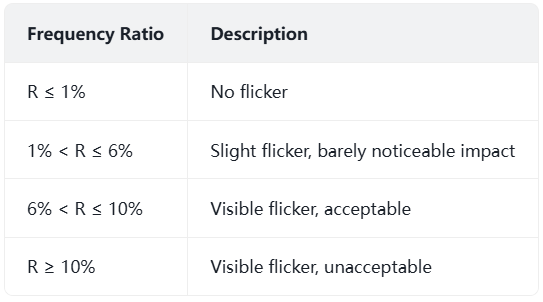
FIFA standards have distinct requirements and suggest particular testing methods that differ from domestic standards. A total of 12 high-frequency test points have been chosen for analysis, as illustrated in Figure 10.
Figure 10 Schematic diagram of flicker ratio test points
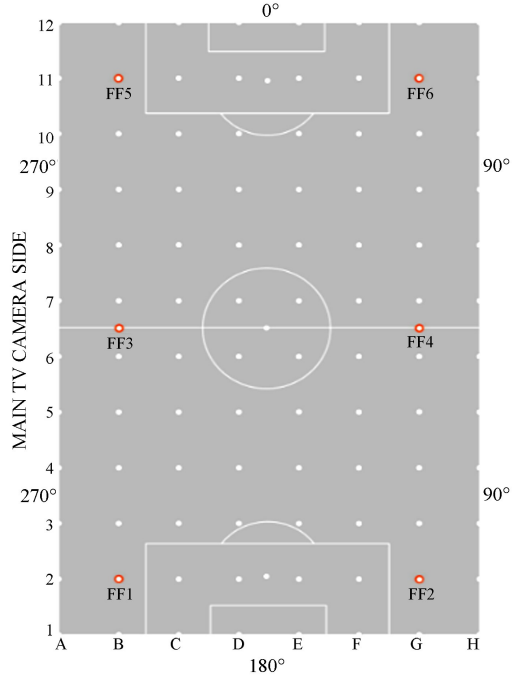
The six flicker ratio test locations depicted in the figure need to measure vertical flicker ratio values at the 90° plane, the 270° plane, and at a height of 1 meter above the ground. The maximum allowable flicker ratio is listed in Table 7.
table7 FIFA Maximum Permitted Flicker Ratio for Each Level of Venue
The average of the 12 data points in the table represents the arithmetic mean, while the maximum value indicates the highest recorded measurement among these points. It is important that the methods used to minimize flicker do not compromise the uniformity of illumination across the surface. Consequently, the lighting system for the venue, which involves overlapping light from various angles, should incorporate 24 flicker ratio test points to maintain consistent illumination across all areas.
While FIFA has relaxed flicker standards for some lower-tier venues, it has introduced more detailed measurement methods, venue limitations, and other new requirements for venues at all levels, which are valuable to consider.
A comparative analysis of the football stadium lighting standards released by FIFA in 2020 alongside domestic standards reveals that FIFA has not only added numerous new lighting evaluation criteria but has also reduced illumination standards for lower-tier venues. This shift indicates a move away from high standards and requirements for lighting towards enhancing the reliability, stability, and continuity of the venues. The author also emphasizes that the design of football stadiums should take into account local climate, environment, resources, and other characteristics. By utilizing energy-efficient electrical equipment and establishing an energy management system based on the lighting index requirements for various venue levels, it is possible to reduce electricity consumption for venue lighting, thereby enhancing the sustainability and efficiency of football field spaces. The FIFA standard sets higher expectations for green performance, including resource conservation, reliability, durability, health, and comfort, which can serve as a significant reference for the low-carbon development of football fields.
3. Best Led Football Stadium Lights
Led Football Stadium Lights A01
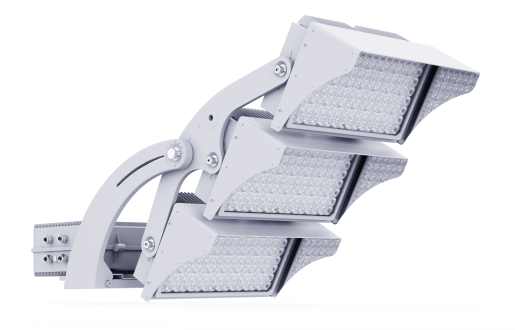
Led Football Stadium Lights A02
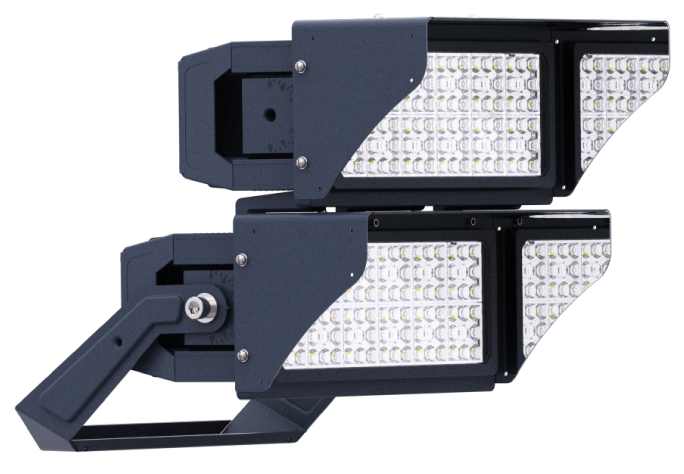
Led Football Stadium Lights B01
